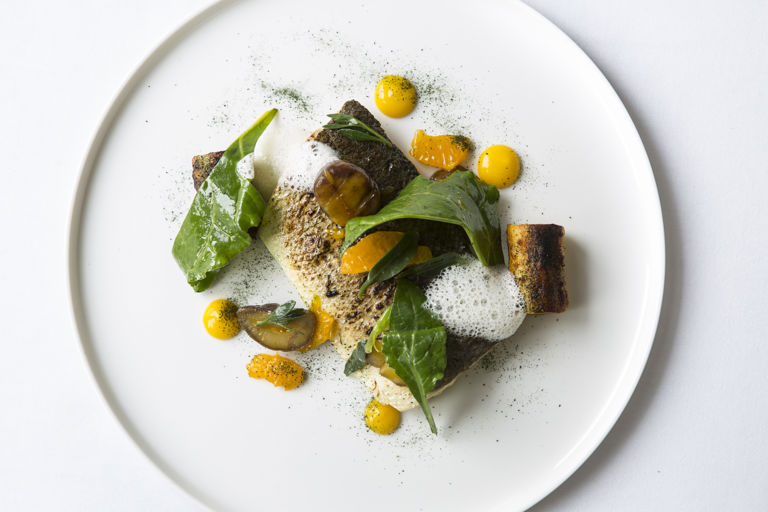Sea bass with seaweed dumplings, clementine and lemon foam
Item 1 of 1
- medium
- 6
- 1 hour 45 minutes
This stunning winter sea bass recipe from Paul Welburn uses seasonal chestnuts and clementines to add both freshness and texture to the delicate fish fillets. A little dried seaweed adds extra oomph to the soft, fluffy potato dumplings – a seafood twist on a classic gnocchi recipe.
First published in 2016
Ingredients
Metric
Imperial
Sea bass
Seaweed potato dumplings
- 1.2kg Maris Piper potatoes
- 100g of 00 flour
- 2 eggs
- 1 knob of butter
- 1 pinch of seaweed, dried and powdered, plus extra to serve
- salt
- freshly ground black pepper
Clementine purée
- 5 clementines, skin on
- 1 vanilla pod, split
- 175g of sugar
- salt
Glazed chestnuts and clementines
- 250ml of orange juice
- 50ml of Chardonnay vinegar
- 1 sprig of thyme, chopped
- 50g of butter
- 100g of chestnuts
- 2 clementines, peeled and segmented
Lemon foam
- 5 lemons, juiced
- 125g of sugar
- 100ml of fish stock
- 20ml of double cream
- 1 tsp lecithin
SAVE RECIPE
Equipment
- Blender
- Hand blender with frothing attachment
- Piping bag and nozzle
Method
1
Begin by preparing the clementine purée. Add the whole clementines and the split vanilla pod to a large pan and cover with water. Place over a medium heat and bring to the boil, then simmer for about 1 hour until the clementines are completely soft, topping up with extra water if needed
- 1 vanilla pod, split
- 5 clementines, skin on
2
Preheat the oven to 200°C/gas mark 6
3
Place the potatoes on a baking tray and cook for 1 hour until cooked right through – this could take longer depending on the size of the potatoes
- 1.2kg Maris Piper potatoes
4
While the potatoes and clementines are cooking, prepare the glaze for the chestnuts and clementines. Add the orange juice, vinegar and thyme to a small pan and place over a medium heat. Allow to cook until reduced by half, then set aside to cool
- 250ml of orange juice
- 50ml of Chardonnay vinegar
- 1 sprig of thyme, chopped
5
Once cooked, drain the clementines from the water and place whole in a blender. Blitz to a smooth purée then add the sugar and a pinch of salt and blend again to combine. Pass the purée through a fine sieve and transfer to a piping bag, setting aside until ready to serve
- 175g of sugar
- salt
6
Once the potatoes are completely soft in the middle, remove from the oven and allow to cool slightly. When just cool enough to handle cut in half and scoop out the soft, dry flesh from inside. Pass through a fine sieve so it is completely smooth and weigh out 1kg into a bowl
7
While still warm add the flour and 1 whole egg to the bowl. Separate the second egg and add the yolk to the bowl, discarding the white. Season with salt and pepper then mix everything together well to form a soft dough. If the mixture feels too wet, add a little more flour to help it bind
- 100g of 00 flour
- 2 eggs
- salt
- freshly ground black pepper
8
Roll the dough into long cylinders and cut into 3cm pieces. Bring a large pan of salted water to the boil and add the dumplings. Cook for a few minutes until they float to the surface, then drain and refresh in iced water. Transfer to an oiled baking tray and set aside until just before serving
10
While the fillets are brining, place the lemon juice and sugar in a pan for the foam and place over a medium heat. Stir until the sugar has dissolved and continue to cook until it forms a syrup. Remove from the heat and transfer into a large bowl, keeping warm until required
- 5 lemons, juiced
- 125g of sugar
11
Rinse the brine from the sea bass fillets with fresh, cold water and pat dry with kitchen paper
13
Meanwhile, add a good drizzle of oil to another pan and place over a medium heat. Lay the sea bass fillets skin-side down in the oil and cook for 5–6 minutes until the skin is golden
- oil, for frying
15
Once the sea bass are almost cooked, add a knob of butter to the pan and flip over to cook on the other side for 30 seconds. Add the sea vegetables to the pan so they just wilt in the heat
- 1 knob of butter
- 50g of sea beet
- 50g of sea purslane
16
Finish the lemon foam by adding the stock, cream and lecithin to the warm syrup and frothing the mixture using a hand blender to create a foam
- 100ml of fish stock
- 20ml of double cream
- 1 tsp lecithin
17
To serve, pipe dots of the clementine purée across each plate and add the sea bass fillets. Divide the dumplings, sea vegetables and glazed chestnuts and clementines between the plates and finish with a dusting of dried seaweed powder and spoonfuls of the lemon foam. Serve immediately
First published in 2016
Get in touch
Please sign in or register to send a comment to Great British Chefs.



